 THE GATEHOUSE
THE GATEHOUSE
“A startling number of alternative histories wind up strengthening the marginal technology of airships and zeppelins,” according to GURPS Infinite Worlds (2005). “This is a matter of flavor rather than logic,” it writes. Be that as it may, airships were for many years the true masters of the skies and iconized what people thought the future would look like. Until the emergence of the aeroplane, the airship was the preferred mode of travel amid the clouds and even considered to be a possible weapon of war.
Steampunk obviously exaggerates the potential of airships yet it is not entirely illogical to presume their greater prevalence were it not for the Hindenburg disaster. TV Tropes is right that “sky pirates and technologically-savvy Nazis” are fascinated with them, preferably when augmented with all sorts of bizarre machinery, but less malicious swashbucklers much enjoy to travel by dirigible in steampunk too.
The Golden Age of airships began at the turn-of-the-century with the launch of the first Luftschiff Zeppelin, named after the Count von Zeppelin who pioneered the construction of rigid airships in the last decade of the nineteenth century. The prospect of airships as bombers had been recognised well before the airships were up to the task. H.G. Wells’ The War in the Air (1908) described the obliteration of entire fleets and cities by airship attack.
The First World War marked the airship’s real debut as a weapon. Count Zeppelin and the German military believed they had found the ideal weapon with which to counteract British naval superiority and strike at Britain herself. More realistic airship advocates believed the zeppelin was a valuable long range scout and attack craft for naval operations. Raids began by the end of 1914, reached a first peak in 1915, then were discontinued near the end of the war.
Zeppelins proved to be terrifying but inaccurate weapons. Navigation, target selection and bomb-aiming were difficult under even the best of circumstances. The darkness, high altitudes and clouds that were frequently encountered by zeppelin missions reduced accuracy further. The physical damage zeppelins inflicted was trivial and the deaths that they caused amounted to a few hundred at most.

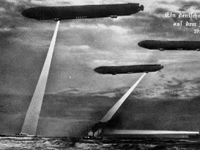

The zeppelins were initially immune to attack by aeroplane and anti-aircraft guns. As the pressure in their envelopes was only just higher than ambient, holes had little effect. But once incendiary bullets were developed and used against them, their flammable hydrogen lifting gas made them vulnerable at lower altitudes. Several were shot down in flames by British defenders, and others crashed en route. They then started flying higher and higher above the range of other aircraft, but this worsened their bombing accuracy and success. Ultimately the bombing campaigns proved to be disastrous in terms of morale, men and material. Many pioneers of the German airship service died in what was the first strategic bombing campaign in history.

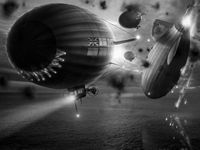

The airship’s historic failure as a weapon does obviously not stop authors and artists of the steampunk genre from presuming otherwise. Dirigibles of all sorts are frequently exploited in steampunk settings as weapons of war. Airship battles in the vein of H.G. Wells’ predictions are depicted while adventures as Jules Verne’s Robur the Conqueror and his Clipper of the Clouds speak to the imagination of steampunk enthusiasts. Airships must be powerful masters of the skies as the ultimate symbols of freedom and defiance, roaming the clouds without hindrance and restraint.
Artwork by Scott Seeto and John Malcolm. Click to hide this item.
Although airships are a popular aspect of the steampunk genre, their heydays came with the era typically associated with dieselpunk rather. While the time period to which the latter refers is not all too strictly defined, the 1930s are practically always included and especially in this decade, zeppelins were supreme. They came to share the skies with that other novelty, the aeroplane, but both coexist elegantly in Sky Captain and the World of Tomorrow (2004). Aeroplanes represent adventure and perhaps a tad of recklessness and certainly danger but airships exhale confidence and grandeur. By no means fragile these leviathans represent to us very much an era that was characterized by progress and great confidence in it. And that is very much characteristic of the dieselpunk fiction set in this era.
Airships came to dominate the skies during the interwar era. Germany continued to push the envelope when it came while Britain contemplated Empire-wide airship service. It was in the United States however that perhaps some of the most ambitious schemes were planned. The Vickers Company proposed to build a craft for trans-oceanic travel, 800 feet long and 100 feet in diameter, able to carry a hundred passenger in outright luxury.
The ironic image of an airship hovering over the skyline of New York City spoke to the imagination of an entire generation. According to Mr David Szondy, airships “seemed to defy all logic as they floated on their moorings like impossible balloons.” While aeroplanes were still prang-prone string kites, “airships evolved into the true liners of the skies. They were the embodiment of gracious living. They advertised to all the world what technology was capable of. And they crossed mighty oceans with ease while planes were hopping puddles.” Airships commanded confidence and generated optimism about the future.
At least, until the Hindenburg went up like a cheap Chinese lantern at Lakehurst, New Jersey in 1937.
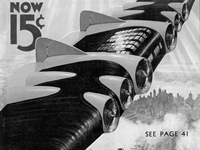
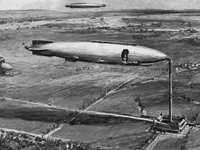
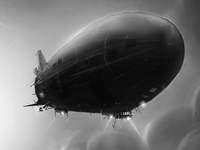
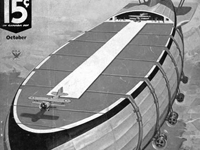
Before the tragic demise of the Hindenburg, however, everything seemed possible. Modern Mechanix proposed the construction of an airship so gargantuan that it could carry a fleet of aeroplanes. The Empire State Building’s distinctive Art Deco spire was originally designed to serve as a mooring mast and depot for dirigibles. The idea proved to be impractical and even dangerous due to the powerful updrafts caused by the size of the building itself. Nonetheless, the image of an airship docking with New York’s greatest monolith came to epitomize the Golden Era of airship travel.
Center artwork by “Vlado”. Click to hide this item.
Steampunk’s history with the airship is a long one. Michael Moorcock has great British airship armadas dominating the skies in The Warlord of the Air (1971) and a German zeppelin blown off-course during a bombing raid of London to wind up in a lost world where dinosaurs still roam in the screenplay of Zeppelin vs. Pterodactyls (1971), a film that unfortunately went unproduced. We behold zeppelins in Steamboy (2004), Perfect Creature (2007) and The Golden Compass (2007) to make it plain that it is quite a different world we are seeing here. Video games as Skies of Arcadia (2000) and Remnants of Skystone (2008) are even set entirely in the air!
Steampunk enthusiasts like to fantasize about adventuring off on board some dirigible, cruising among the clouds in search of excitement and fanciful escapades. We imagine powerful masters of the skies able to thwart any dangers encountered up there and fragile little blimps crafted by eccentric engineers and inventors. “By imagining ... everyday life on a zeppelin, steampunk neutralizes and thus, ironically, fetishizes danger,” writes Rebecca Onion.
Beholding a sky filled with “bulbous aircraft rather than hovercars or spaceships,” we presume to see a world similar to our own that “just happened to follow a different technological route,” according to TV Tropes.
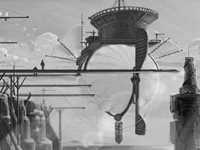
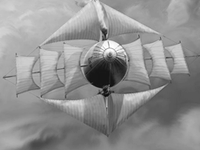
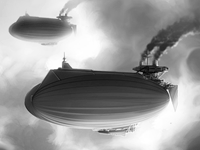
Sometimes airships become to gargantuan that they evolve into true masters of the skies, the size of small cities, able to carry hundreds of people and to go without ever setting eyes upon the ground. Crafts depicted in these illustrations by Embrah Elmasli and Ryan Church are so large that they may serve as last redoubts of civilization, should the apocalypse come by unannounced. That, or as the private domains of some mad scientist or band of buccaneers.
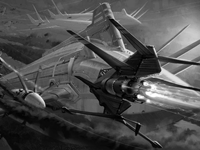

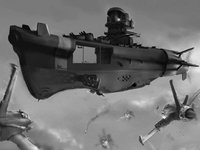
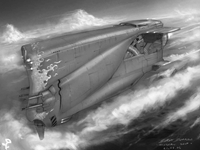
Artwork by Hawkfish, Drew Northcott and Alister Lockhart. Click to hide this item.

For more zeppelins and dirigibles, visit our SMOKING LOUNGE.